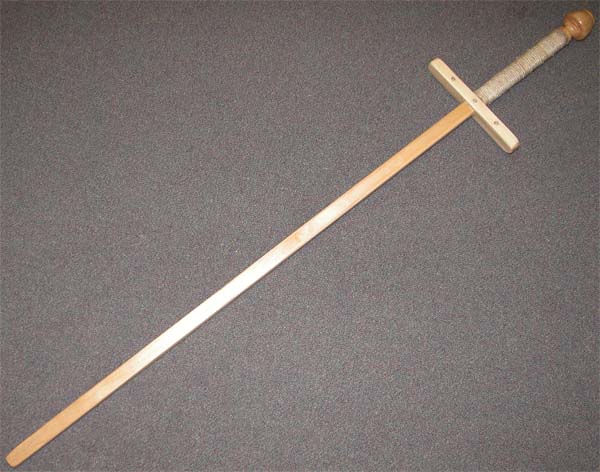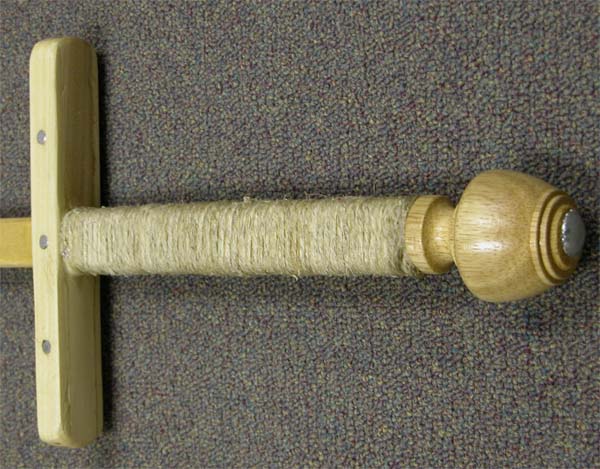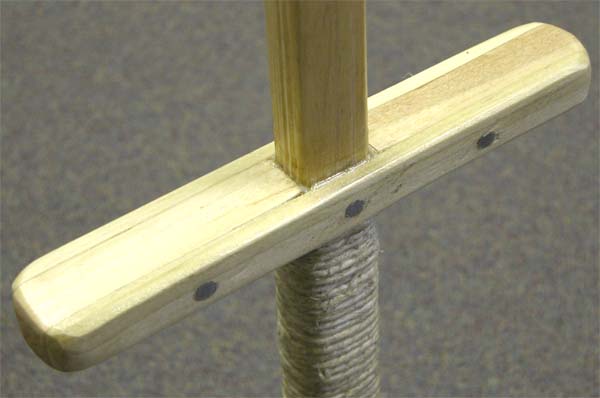Hello:
I'm interested in learning how to use a long sword. Hopefully, I'll move to a city with an ARMA chapter or something similar. I figure using a wooden sword is safer and less expensive than a real sword. I realize "wasters" are available on-line, but some seem rather expensive in my opinion. I am wondering why I couldn't build one myself?
Are plans for making your own wooden practice sword available somewhere? I'd like to make my own bastard or two-hander practice sword. I own both of Mr. Christian Tobler's German Longsword books and need to practice as I read them.
What kind of wood should I use?
Thank you! :-)
While I'm not personally aware of any particular plans myself, I would like to add a point to consider when looking into anything, whether you choose to purchase or build on your own.
With the wasters I have had the privilege of using (whether I bought them or borrowed - I've never made any myself), I have noticed a significant variation in weight and weight distribution. Namely, that often times wasters you'll find are too light and lack the momentum to spar realistically. More common than this, however, is the fact that it is harder to distribute weight evenly with wood than with metal, leading to a sword with the center of balance halfway between the point and the pommel, or rather, much higher than it should be.
Anyway, just take a look at the types of wood and the makeup of the blueprints or plans you look at and see if this has been accounted for, as it often isn't from the ones I have handled.
With the wasters I have had the privilege of using (whether I bought them or borrowed - I've never made any myself), I have noticed a significant variation in weight and weight distribution. Namely, that often times wasters you'll find are too light and lack the momentum to spar realistically. More common than this, however, is the fact that it is harder to distribute weight evenly with wood than with metal, leading to a sword with the center of balance halfway between the point and the pommel, or rather, much higher than it should be.
Anyway, just take a look at the types of wood and the makeup of the blueprints or plans you look at and see if this has been accounted for, as it often isn't from the ones I have handled.
They're not overly difficult to make yourself, I don't think that you need schematics. If you have a jigsaw and dremel tool you have all that you need. Short of that, something that can cut wood and some sand paper could do the job (but it would take much longer). Just make sure to use the right kind of wood. Most of the better wasters are made from what is called "impact grade" hickory. You will not find this at Home Depot or Lowes, you will need to call some lumber yards. "Impact grade" is not as dry as cabinet grade wood, which will split.
Of course, if you want it to look nice, it will take longer. The waster that I use was made by Purpleheart Armoury. It is very nice and was a very reasonable price. The handle and blade are one piece, and the guard and pommel are glued on. I have also heard good things about New Stirling Arms, but I don't own any of their wasters.
Of course, if you want it to look nice, it will take longer. The waster that I use was made by Purpleheart Armoury. It is very nice and was a very reasonable price. The handle and blade are one piece, and the guard and pommel are glued on. I have also heard good things about New Stirling Arms, but I don't own any of their wasters.
I've used cheap street hockey sticks to make wasters. These things are very dense and strong laminated wood designed for hard use, and the plastic blades are attached with a screw--easily removed. I think I paid about $10 each for the ones I used. I used an egg-shaped wooden curtain rod finial for the pommel and attached it to the blade/tang with a long and robust lag bolt to add weight. I drilled out the tip of the blade and screwed a long, threaded steel .25" dowel in as far as possible then sawed it off flush with the wood and sanded. That adds weight and pushes the balance toward the tip. I assembled the poplar cross in place with epoxy and the same method I used on the tip of the stick, with three threaded metal .25" pins--one in the center, through cross and blade, and one in the middle of each quillon. Hemp twine and glue for the grip.
I'd change a few things if I were doing it today, but these seemed pretty solid. I made `em for a friend and I don't know how they've held up over the years (or if they were used for training). They were nice looking, anyway. I don't recall weight and balance.
I'd change a few things if I were doing it today, but these seemed pretty solid. I made `em for a friend and I don't know how they've held up over the years (or if they were used for training). They were nice looking, anyway. I don't recall weight and balance.
Found some photos (none showing the internally-weighted tip, but it's finished just like the threaded pins in the cross). I think this was my first arms and armour workbench project back in 2002. I based it on documented longsword proportions so I wasn't just winging it. I could certainly do a better job on fit and finish now. Still, I see only a few things I'd want to change. Some serious testing might suggest design changes. Anyway, it's just one of many ideas out there.
 Attachment: 81.09 KB
Attachment: 81.09 KB

 Attachment: 100.15 KB
Attachment: 100.15 KB

 Attachment: 56.13 KB
Attachment: 56.13 KB




I'm using ash myself.
I did not try my hands at longsword wasters yet, but I did not find making good wasters particularily hard. The theoretical information required's available online and the tools needed are easily found: A tablesaw or a bandsaw and a planing machine plus some files. The only thing I had to purchase was a draw knife.
The process is easy too. Find a sword you like and get some measurements. I took mine from "The sword in the age of chivalry". Draw it out 1:1 on a piece of paper and copy it onto a board of wood. Don't forget to account for distal tapper though. I myself used a simple linear distal tapper and decided to thin the blade down to about half over the whole lenght starting from the cross. I usually startet out with a slab of wood 5cm thick and thin it down to a tip about 2.5 cm thick on the planing machine. My first waster was a type XVIIIa which had its balance point about a third down the blade after the pommel and guard had been added.
I did not try my hands at longsword wasters yet, but I did not find making good wasters particularily hard. The theoretical information required's available online and the tools needed are easily found: A tablesaw or a bandsaw and a planing machine plus some files. The only thing I had to purchase was a draw knife.
The process is easy too. Find a sword you like and get some measurements. I took mine from "The sword in the age of chivalry". Draw it out 1:1 on a piece of paper and copy it onto a board of wood. Don't forget to account for distal tapper though. I myself used a simple linear distal tapper and decided to thin the blade down to about half over the whole lenght starting from the cross. I usually startet out with a slab of wood 5cm thick and thin it down to a tip about 2.5 cm thick on the planing machine. My first waster was a type XVIIIa which had its balance point about a third down the blade after the pommel and guard had been added.
Keep in mind that a wooden sword of the same dimensions and profile as the metal sword it's meant to emulate will not necessarily be a good training tool. Length, weight and balance are the first considerations.
| Sean Flynt wrote: |
| Keep in mind that a wooden sword of the same dimensions and profile as the metal sword it's meant to emulate will not necessarily be a good training tool. Length, weight and balance are the first considerations. |
Speaking of that, why did you feel you needed to weight the tip of the sword? I would have thought that shifting the balance in the other way would be the main problem, actually it seems to be on most wasters I've seen... Or I'm widely misundertanding the original balance of the hockey stick :)
I don't recall the details, but as dense as the stick is it still wasn't what I needed, weight-wise. Using the large bolt in the pommel helped, but that pulled the balance too far up the sword. The extra weight at the extreme opposite end added a bit more weight overall and helped pull the balance back the other way.
| Sean Flynt wrote: |
| I don't recall the details, but as dense as the stick is it still wasn't what I needed, weight-wise. Using the large bolt in the pommel helped, but that pulled the balance too far up the sword. The extra weight at the extreme opposite end added a bit more weight overall and helped pull the balance back the other way. |
Well you might get appropriate weight and maybe even point of balance this way, but it will be significantly less agile than a real sword. Basically the weight in the waster is spread out at both ends, when the mass of a sword is concentrated in the hilt. That makes a big difference in moment of inertia...
I'm going to try making a one-handed sword waster soon, just to see if I manage to apply my knowledge of balance to a real-world object :)
| Vincent Le Chevalier wrote: |
|
Well you might get appropriate weight and maybe even point of balance this way, but it will be significantly less agile than a real sword. Basically the weight in the waster is spread out at both ends, when the mass of a sword is concentrated in the hilt. That makes a big difference in moment of inertia... |
In this case, the weight was still concentrated between these extremes. We're not talking about enormous weight in the ends--maybe a 3" rod in the tip and 4" bolt in the pommel. There's still a fair amount of weight at the cross, with those three steel pins. It handled like an agile sword rather than like a baton, in other words. I hasten to add that this probably wouldn't be true if using something other than this narrow, thick, parallel-edged laminate. It's dense stuff, and the zero-taper profile must be addressed somehow. I wish I had one of these handy to get stats on COG, COP and weight. There certainly are better alternatives for sale but they're for sale :D
Page 1 of 1
You cannot post new topics in this forumYou cannot reply to topics in this forum
You cannot edit your posts in this forum
You cannot delete your posts in this forum
You cannot vote in polls in this forum
You cannot attach files in this forum
You can download files in this forum
All contents © Copyright 2003-2006 myArmoury.com — All rights reserved
Discussion forums powered by phpBB © The phpBB Group
Switch to the Full-featured Version of the forum
Discussion forums powered by phpBB © The phpBB Group
Switch to the Full-featured Version of the forum